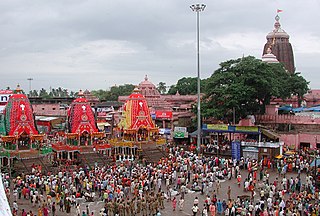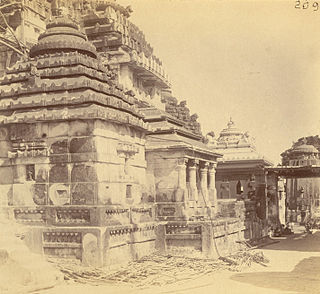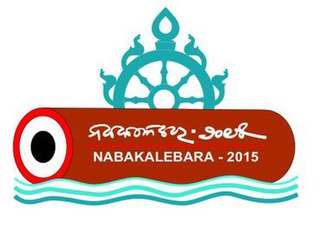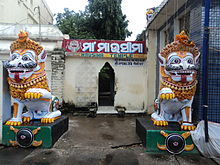
Jagannatha is a deity worshipped in regional Hindu traditions in India as part of a triad along with his (Krishna's) brother Balabhadra, and sister, Subhadra. Jagannath, within Odia Hinduism, is the supreme god, Purushottama, and the Para Brahman. To most Vaishnava Hindus, particularly the Krishnaites, Jagannath is a form of Krishna, sometimes as the avatar of Vishnu. To some Shaiva and Shakta Hindus, he is a symmetry-filled tantric form of Bhairava, a fierce manifestation of Shiva associated with annihilation.

The Ratha Yatraof Puri, also rendered as the Ratha Jatra, is considered the oldest and largest Hindu chariot festival celebrated annually, on the bright half of the lunar month of Ashadh (June–July). The festival is held at the city of Puri, in the state of Odisha, India and associated with the deity Jagannath. During the festival, three deities are drawn by a multitude of devotees in three massive, wooden chariots on bada danda to Gundicha Temple whereby they reside there for a week and then return to the Jagnannath temple. This return trip is referred to as the Bahuda Yatra.

Puri, also known as, Jagannath Puri, is a coastal city and a municipality in the state of Odisha in eastern India. It is the district headquarters of Puri district and is situated on the Bay of Bengal, 60 kilometres (37 mi) south of the state capital of Bhubaneswar. It is home to the 12th-century Jagannath Temple and is one of the original Char Dham pilgrimage sites for Hindus.

The Jagannath Temple is a Hindu temple dedicated to the god Jagannath, a form of Vishnu in Hinduism. It is located in Puri in the state of Odisha, situated on the eastern coast of India. As per temple records, King Indradyumna of Avanti built the main temple of Jagannath at Puri. The present temple was rebuilt from the tenth century onwards, on the site of the pre-existing temples in the compound, but not the main Jagannath temple, and begun by Anantavarman Chodaganga, the first king of the Eastern Ganga dynasty. Many of the temple rituals are based on Oddiyana Tantras which are the refined versions of Mahayana Tantras as well as Shabari Tantras which are evolved from Tantric Buddhism and tribal beliefs respectively. The local legends link the idols with aboriginal tribes and the daitapatis (servitors) claim to be descendants of the aboriginals. The temple is one of the 108 Abhimana Kshethram of the Vaishnavite tradition.
Mausimaa Temple is an ancient shrine located in Kulada, a village also contains the Bagh Devi temple, in Ganjam District of Odisha, India. It is about 8 km from Bhanjanagar.
Upper Bagh Devi Temple is an ancient shrine at Kulada, Ganjam District in the state of Odisha in India. The temple is about 8 km from Bhanjanagar, 102 km from Chhatrapur and 140 km from Bhubaneswar. The nearest railway station is at Berhampur, 88 km away.

Maa Mangala Mandir is a Hindu Shakti Pitha located in Kakatpur of Odisha, on the eastern coast of India.

The Snana Yatra, also spelt Snana Jatra, is a bathing festival of deities celebrated on the purnima of the Hindu month of Jyeshtha. It is the auspicious birthday of Jagannath.

Gundicha Temple, is a Hindu temple, situated in the temple town of Puri in the state of Odisha, India. It is significant for being the destination of the celebrated annual Rath Yatra of Puri. While it remains vacant most of the year, the temple is occupied by images of the deities of Jagannath, his brother Balabhadra and sister Subhadra for seven complete days every year during the annual Rath Yatra festival.

Raj-Ranpur is a town and a Notified Area Council in the district of Nayagarh in the eastern Indian state of Odisha. The town is also known as Ranpurgarh or simply Ranpur as per the modern usage. The town is historically significant especially during the British Raj when it was the capital of the princely state of Ranpur. The martyrs Shaheed Raghu-Dibakar who were hanged for their resistance to British rule belong to this place. Rajsunakhala and Tangi are the nearest Town of Raj-Ranpur, which in almost 10 to 20 km from the town. Rajsunakhala is the most important business centre in Ranpur block under Nayagarh district.

The Jagannath Temple in Hyderabad, India,Telangana, is a modern temple built by the Odia community of the city of Hyderabad dedicated to the Hindu God Jagannath. The temple located near Banjara hills Road no.12 (twelve) in Hyderabad is famous for its annual Rathyatra festival attended by thousands of devotees. Jagannath means Lord of the Universe. The temple which was constructed during 2009 recently lies in Center of Hyderabad City.

Shri Shri Hari Baladev Jew Bije is a famous Hindu temple located in Baripada, Mayurbhanj district, in the state of Odisha, India. The name Jagannath is a combination of the Sanskrit words Jagat (Universe) and Nath.

The Vimala Temple or Bimala Temple is a Hindu temple dedicated to goddess Vimala or Bimala (ବିମଳା), located within the Jagannath Temple complex in Puri in the Indian state of Odisha. It is generally regarded as a Shakta pitha, among the holiest temples dedicated to the Hindu Goddess.

Ratha Yatra, or chariot festival, is any public procession in a chariot. They are held annually during festivals in India, Nepal and Sri Lanka. The term also refers to the popular annual Ratha Yatra of Puri that involves a public procession with a chariot with deities Jagannath, Balabhadra, Subhadra and Sudarshana Chakra on a ratha, a wooden deula-shaped chariot.

The Maa Tarini Temple in Ghatgaon is a famous Hindu Goddess temple dedicated to Maa Tarini.

The Nabakalebara 2015 is a celebration of the ancient ritual of the Nabakalebara associated with most of the Jagannath Temples when the idols of Lord Jagannath, Balabhadra, Subhadra and Sudarshan are replaced by a new set of idols; the last such festival of events was held in 1996. The period of the festival is chosen according to the Hindu Calendar, conforming to the astrological planetary positions. The festival during 2015 involves several schedules, and it has started from 23 March with Banajaga Yatra and will conclude with Rathayatra followed Sunabesa on 27 July, with many other rituals being held in between on specific dates. More than 5 million devotees are expected to participate in these rituals held in and around the temple complex of the Jagannath Temple, Puri, Odisha.

Suna Besha, also known as Rajadhiraja beshaRaja Besha, Bada Tadhau Besha andRajarajeshwara Besha, is an event when the Hindu deities Jagannath, Balabhadra and Subhadra are adorned with gold jewelry. Suna Bhesha is observed 5 times during a year. It is commonly observed on [pousha purnima ] Purnima (January), Bahuda Ekadashi (July), Dashahara (October), Kartik Purnima (November), and Dola Purnima (march). The name Suna Bhesha is derived from two words, 'Suna' meaning "gold" and 'Bhesha' meaning "costume".

Jagannath Temple, Rayagada, stands at the southern side of the town Rayagada. The temple was originally built more than 50 years back.

Poṛa Piṭhā is slow-cooked pitha. It is made by slowly baking fermented rice, black gram, grated coconut and jaggery overnight. Its crust is slightly burnt, while the inside is soft and white. Poda pitha is generally made during Raja Parba. It is served to Lord Jagannath and his siblings at Mausi Maa Temple on their way back after Ratha-Yatra, from Gundicha Temple to Jagannath Temple, Puri.


















